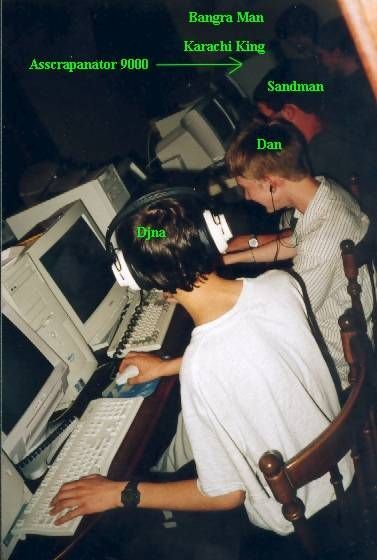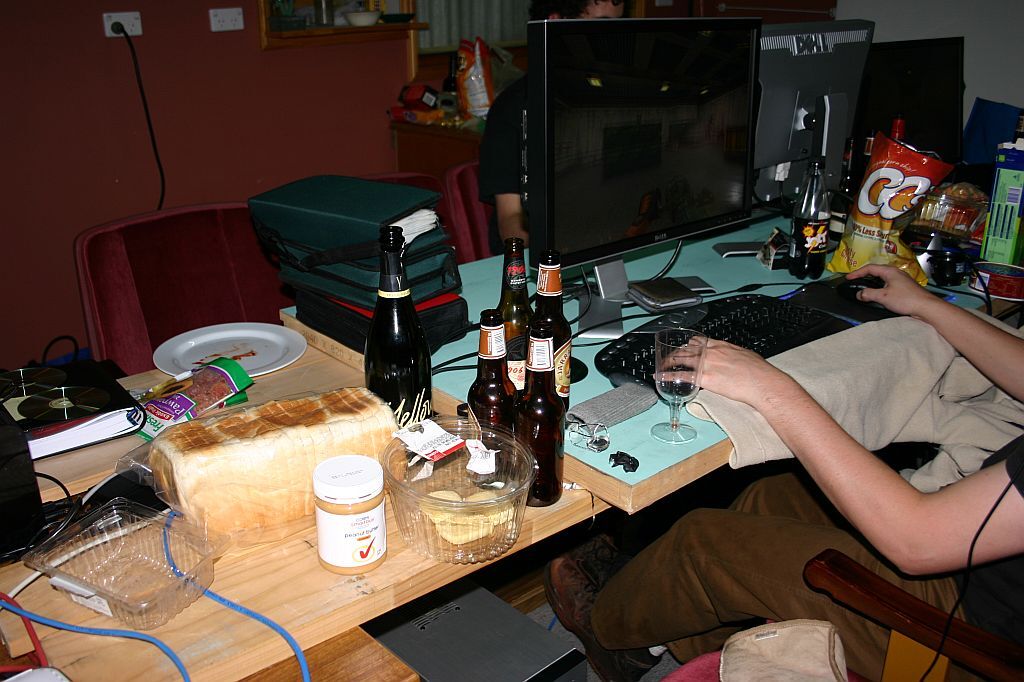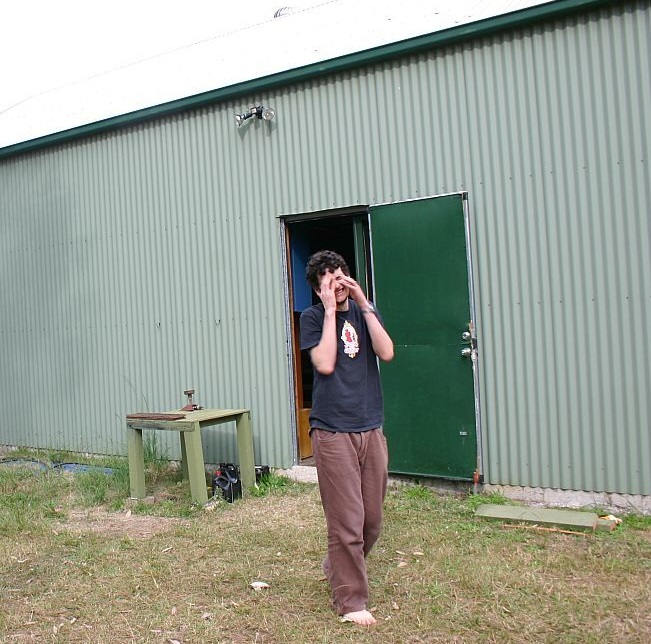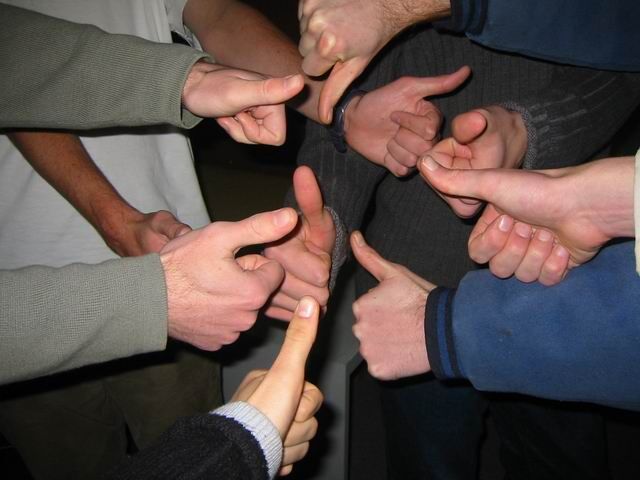📅 Posted 2019-03-03
Back in the day, I used to attend a fair amount of LAN parties. Dragging my PC and giant CRT monitor along to random houses to play games all night sure was fun so I’m going to look back at what all the fuss was about.
What’s a LAN party, anyway?
(I’ll save the hassle and just call them “LANs” from now on)
For those who aren’t familiar, haven’t been or haven’t heard about ’em, I’d say there’s a basic formula although no two LANs will be the same. For me, some of the elements were:
- A gathering of people hugely into video games, usually between 6 to 8 people
- Bringing all your equipment with you:
- PC, monitor, keyboard, mouse
- Headphones (or speakers if you owned the sub of doom)
- Fan optional. Very useful in Summer
- Food. Essential LAN food (for us) was always Doritos, Mountain Dew and (strangely) peanut butter and bread
- Optionally: something to sleep on (who sleeps anyway?), a seat and a table (venue dependent)
Here’s a photo of me with giant headphones in someone’s garage surrounded by a collection of CRT monitors:
Some context: why we needed to meet up and “those dial-up days”
The main reason for meeting at a single house to play games was pretty much due to the lack of internet in Australia at the time. Of course, we had The Internet, but it was pretty much only dial-up unless you were super lucky and got cable or ISDN at work.
One of the main benefits of a LAN was playing games with zero lag - as anyone who was used to dialling up their ISP and tying up the phone line will attest to, being “lagged” out of a game was pretty rubbish. The average ping time for a local server would be around 200ms, which could mean life or death in fast-paced first person shooter games. “Ping” or “latency” is pretty important: 200ms is a fifth of a second and measures the time it takes information to get from your computer, to the server which you’re connected to, and back. A lot of action can happen in a fifth of a second, so timing is everything.
The second problem was the amount of servers available online in Australia: if you did happen to find a local server, it was probably full. Or playing a game you didn’t want to play. For anything else, you’d have to look abroad to the US and deal with 300+ms ping times - definitely unplayable at this level.
So, bring in the LAN with our 100mbit (and later, gigabit) connections with zero lag across the network. Of course. there was lag sometimes but only if someone happened to bring a 10 megabit network card and everyone would “ping of death” their computer just for kicks. Meanies.
Oh yes, and the thing about dial-up wasn’t just about the terrible lag. Downloading anything took forever, so the only way to truly do it was to have everyone download many things over a period of months, then gather together and swap. It’s sometimes called “leeching” and it was a very effective way of downloading a lot of files at once. It was also a great activity to do when you were tired of playing a game and needed a break: you could check out everyone’s shared folders on the network to see what they had.
More than that…
It was more than just technical limitations of the Information Super Highway at the time. It was also a great social event where you could spend countless hours fragging your friends and then stand up and bask in the glory (such as airing your shirt in what was to be known as “shirt motion”) or hide in the corner when you got completely owned.
The simple fact was: it was just loads of fun. The longest LAN event we ever had was in the venerable LAN shed, which was nicely tucked away from civilisation and allowed you to make as much noise as you wanted any time of day or night. The LAN lasted for a full week: people would go to work and return, or even go home for a shower (hygiene often took a backseat at such events).
The early days
Back in the early days, probably the first LAN I could think of would’ve been in the mid-late 90’s. It was high school, and playing video games was all the rage. I was always a “PC guy” because we never had consoles at home, only computers. Which is fine because you can do your homework OR procrastinate and play games instead.
After getting my own computer (from various hand-me-down parts as well as attending the “Computer Fairs” which used to run monthly at North Rocks or Parramatta, amongst other locations), I was able to attend the first LAN that I can call a “LAN”.
The venue was a barn-like shed at the back of a friend’s parents house. Nicely done: it would avoid generating too much noise for the family - something you should take into account when inviting a bunch of people over to play games all night… I can picture the time because the Quake III Arena Test was just released in April 1999 and we were all desperate to play it on our computers. Someone had to download it first! Which took ages, dial-up and all. I couldn’t run it on my computer! I had to download some new video drivers, for my ATi “All-in-Wonder Pro” which was a low-spec 3D video card with TV tuner capabilities powered by ATI’s Rage Pro chip. This was done at the LAN (of course) but being dial-up, meant I had to wait a couple of hours to get the thing going. It worked.
Surprisingly, the Quake III Arena Test still runs on modern Windows with modern hardware (also Amazon Rekognition instantly recognises this photo as “Quake”):
Photos are thin on the ground for the early days, partly because digital cameras weren’t a thing (or we couldn’t afford them). I should find out to see if we have any earlier photos - from actual film - tucked away somewhere.
Here’s a couple of photos of an early LAN, from the late 90’s - I’m the one indicated with “Djna”. As for “Asscrapantor 9000”, this wasn’t a person as such but the worst computer at the time. This one was hosted in a friend’s living room, which meant we had to keep things down over night.
Talking food for a moment
It was pretty much all about the junk food. Lunch, Dinner and Breakfast optional. In fact, even if you organised food (BBQ or otherwise) nobody would really eat it because they were too obsessed with playing games (and probably full of junk food, too…).
Mountain Dew was always a favourite, although I’m not entirely sure why. Here in Australia, it didn’t have caffeine in it, so it just tasted like weird fizzy fruit something. We called it Crab Juice, thanks to Homer Simpson.
Booze came along as people got older, of course, but I don’t think it did much to improve skill. Riding the wave of the Ballmer Peak is tricky and not for the faint-hearted.
One time we had a massive storm, a blackout and a tree across the driveway. One of the LAN goers did a shift at a certain large pizza chain and then rocked up with a stack of pizzas, which is great fuel for gamers and became a bit of a tradition. Unfortunately, with a tree across the driveway it meant we had to carry boxes of pizzas over the large tree trunk. He was particularly disappointed to hear we had no power, so then no LAN… But at least we had pizza!
Equipment of choice
In the beginning, it was all beige PCs with beige CRT monitors and beige keyboards, which was ridiculous. Actually, we didn’t even have cars, so we had to scab a lift off our parents and carry all manners of equipment and set up on a bunch of tables - whatever was on offer at the host’s house. Some people would go as far as bringing their chair from home.
Rule #1: always have internet. Even if it’s dial-up and has to run via a cable out the front door, down the yard and into the garage. You never know when you might need to download some drives or a patch for a game. Of course, sharing a dial-up connection across 8 people is … hopeless. But you knew that already.
Big monitors were a thing, unfortunately… And that’s someone’s kitchen in the background.
… but luckily paved the way to LCD monitors, once they became affordable. How we were survived with such giant monitors all the time I will never know!
This photo was taken in the LAN shed which was a common venue for our LANs. One CRT monitor still remains, but it’s pretty much all LCDs by this point in time. A large white projector screen can be seen as well - for movies! But there’s no time for movies when you’re playing games.
Here’s a random gratuitous innards photo of an LAN attendee’s PC - I can’t remember who, but all of the PCs pretty much looked like this - possibly not always this clean, however.
Laptops were generally not brought along, despite being super easy to carry and setup. They just didn’t have the grunt or storage to match a built PC - at least in a price range that we could afford.
But what about the games?
For us, CS was the defacto choice since it came out in November of 2000. We played many hours of Counter-Strike, a great mod for Half-Life, game of the year in 1998. I distinctly remember having a LAN in one of a friend’s lounge rooms and for those who didn’t feel the need to install the game, they found it shared on the network and simply double-clicked on the executable and ran it across the network. It worked, sure, but dang it was slow.
The following image was aptly titled “Bog of Hurties”:
Some of the games we used to play a lot of were:
- Any Half-Life mod, including CS, Action Half-Life, Science and Industry or Day of Defeat
- Quake, Quake II and Quake III Arena
- Starcraft, C&C Generals
- Battlefield 1942 (which we never actually played properly, we just messed around with planes and tried to do stupid things like fly them under bridges)
- Multris - Tetris is so much better with many players
- Diablo II - which you could easily identify by the frantic mouse clicking action which would fill the room
- Need for Speed: Underground - which had the amazing ‘feature’ that if you lowered your graphics quality, the game would run faster, and you would win all of the races
Emulation was a common choice too, since PCs could run most games from any prior generation. These wouldn’t be played multiplayer generally, but played in between games since they’re quick to load and get into.
Other random games also cropped up: it was a way to find out about other games you had never heard of and see what other people were playing. Gather enough interest and others might join you. Here’s a fun little game called Elastomania:
Score screenshots
Here’s a few screenshots of scoreboards, of course I usually only grabbed the ones where I was doing OK! I’m the_real_nisch in this screenshot (probably because we had a time when everyone would clone each other’s name for a few laughs).
… And me not doing so well (this time I’m Nischby):
Setting up
Here’s a typical LAN setup:
There was always some sort of hassle getting things to work. It’s part of the charm, I guess. Thankfully, help is on hand to sort things out.
Networking was often one of my things, or at least I would be the one to bring the hub (later switch) and a box of cables to get everyone going. I don’t think we ever used coax, so it was pretty much Ethernet from day one for us. Oh the luxury!
Over time, we got better at setting up networks. We got DHCP servers, we ditched IPX as a protocol (it was still huge in the gaming world though), we didn’t spend ages with random computers not being able to “see” or “share” files with each other. If you didn’t spend a few hours setting it all up in the beginning, then it’s not a real LAN. A pair of 100mbit hubs kept us out of trouble for many years, although networks did improve and get faster over time.
The choice of venues
Starting off with the classic venue: The LAN Shed.
A few things were always considered when choosing venues. We also moved the various LANs around, so we did have a go at a few different combinations.
In Summer, you want some place which is cool. Generally speaking, nobody had aircon at the LAN, so bringing a fan was advised but could only do so much.
For noise, you’d want to be away from everyone’s family, who are no doubt trying to sleep at night and don’t care if you just captured the flag for the fifth time in a row.
You want somewhere convenient, which is close enough to all the guests, although given this is Sydney, people don’t mind that much if they have to drive a couple of hours from the Central Coast if the LAN is going to run all weekend.
You’ll need a lot of tables and chairs. Often someone’s garage with the cars removed is a great option.
You’ll need plenty of power: but despite all of the computers and all of the powerboards and all of the extension cables, we never once blow a circuit breaker. So I guess computers don’t really draw that much power after all.
Speaking of power, we had a LAN during a blackout after a storm, that was pretty disastrous. In the end, after everyone become completely board of playing games like Monopoly (which is one of the worst board games of all time), we had to pack up shop and find someone else’s house with power. It was amusing at the time calling around to find who had power.
I did attend a public LAN once - I say public but it was ticketed - in a hall somewhere. Details are sketchy, and even after asking a friend he wasn’t sure either. Let’s just say it was in a community hall in Burwood or Strathfield or somewhere like that. It was good, but without really knowing people then it’s quite a different experience.
Common themes
Looking back at a few photos I had from LANs, we did a lot of “thumbs up” for some reason. Who knows why.
Here’s my watch (note I’m not a watch person, so this photo is rare) showing it’s 3AM. Importantly, sleep is for the weak.
Oh no! Zee natural light! It burns!
It’s very important that at least one person reinstalls Windows during the LAN. Bonus points if many people need to do this.
Running a server was sometimes good: it meant if the host was sick of playing a game, you didn’t just get turfed out all at once. It also meant game servers were always up and running and ready to be joined. In the end, though, we were never really that organised to rely on running local servers. I guess if you had a bigger event it would be far more important.
And moar thumbs!
Sometimes we’d try out the latest hardware in the pursuit of trying to get the best score in some benchmarks. 3DMark was a great tool for showcasing your latest video card purchase. Showing the money was never really very important - there wasn’t much point in bringing the latest and greatest hardware if nobody else could play games that wouldn’t run on their computers. But it was fun to see the eye candy on some of the 3D rendering tests.
A new language
A lot a terms were either invented or modified for use during our LANs. The group of people who attended did change over time, but pretty much centred around friends from a few different schools in Western Sydney. Here are some of the words and phrases we used:
- Fwoa: “it means fwoa… which is generally a ‘yeah!’ like term…” which can be seen in Urban Dictionary. Pretty sure we added it many years ago.
- Fwoasby: the general consensus that lots of “fwoa” activity is going on.
- Shirt Motion: the lifting of the front or rear collar of a t-shirt in a waving motion when you’ve achieved something amazing, usually accompanied by saying “Ahhh!”.
- Noiter: the team formed by Nato and Boyter, however was infiltrated by others who added the tag to their nicknames without realising it was created by merging the names “Nato” and “Boyter” together.
- Nahoi: term coined by Professor Frink from The Simpsons, used when announcing you’ve achieved something truly nerdy.
- Asscrapanator 9000: the specific term used to describe the worst and slowest computer at the LAN, specifically Ryan’s computer.
- Beast: the fastest and best computer at a LAN.
- -z0r: a suffix added to many words to make them sound more nerdy, such as “server” becomes" servz0r".
- Fat: nothing to do with the size or weight of a person, but used if someone displays laziness.
(I’ve skipped over some other common terms which are used by gamers, such as ownage, frag, etc.)
Here’s a close-up of the Asscrapanator 9000 in all it’s glory, used to stop a door swinging in the wind:
Meanwhile, elsewhere
I had always wanted to go to a real massive LAN, such as DreamHack or The Gathering, but considering both options are overseas, this was never really possible. I couldn’t imagine dragging my CRT monitor that far! But I guess if you were dedicated enough…
Oh man, a stadium size LAN. That’s impressive. I’m still keen.
These days (aka the downfall of the LAN)
I can’t remember the last time I went to a LAN. We have tried to organise several, but everyone is so busy these days. Jobs, families, travel, you name it. It was just so much easier when you were in high school or uni to organise an event. Even the ’net is faster these days - sure, the NBN can’t compete on the world stage, but it’s still a lot better than dialup. And that’s saying something.
I still want to go to another LAN - it won’t be the same or as good - but it will still be fun.
Like this post? Subscribe to my RSS Feed or


































Comments are closed